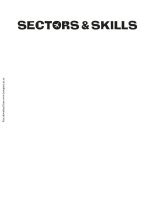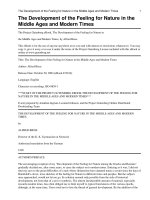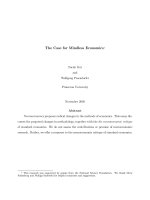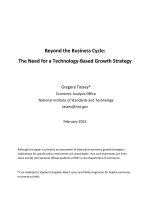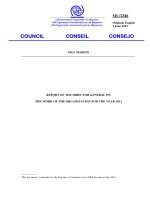preparing the patient for insulinshort
Bạn đang xem bản rút gọn của tài liệu. Xem và tải ngay bản đầy đủ của tài liệu tại đây (950.13 KB, 42 trang )
International Diabetes Center
International Diabetes Center
Preparing the Patient
for Insulin Therapy
International Diabetes Center
International Diabetes Center
Preparing the Patient for
Insulin Therapy
•
Understand natural history of diabetes
Understand natural history of diabetes
and treatment options (SDM)
and treatment options (SDM)
International Diabetes Center
International Diabetes Center
Preparing the Patient for
Insulin Therapy
•
Understand natural history of diabetes and treatment
Understand natural history of diabetes and treatment
options (SDM)
options (SDM)
•
Review targets for blood glucose and
Review targets for blood glucose and
HbA1c
HbA1c
Treat to Target
HbA1c
HbA1c
< 7%
< 7%
Fasting and Pre meal glucose
Fasting and Pre meal glucose
70-140 mg/dL (3.9-7.7 mmol/L)
70-140 mg/dL (3.9-7.7 mmol/L)
Postprandial glucose
Postprandial glucose
<160 mg/dL (8.8 mmol/L)
<160 mg/dL (8.8 mmol/L)
(
(
Two hours after the start of a meal the BG should
Two hours after the start of a meal the BG should
be no more than 20 to 40 mg/dL or 1.1 to 2.2 mmol/L
be no more than 20 to 40 mg/dL or 1.1 to 2.2 mmol/L
above the pre-meal BG
above the pre-meal BG
)
)
Bedtime glucose
Bedtime glucose
100-160 mg/dL (5.5-8.9 mmol/L)
100-160 mg/dL (5.5-8.9 mmol/L)
International Diabetes Center
International Diabetes Center
International Diabetes Center
International Diabetes Center
Preparing the Patient for
Insulin Therapy
•
Understand natural history of diabetes and treatment
Understand natural history of diabetes and treatment
options (SDM)
options (SDM)
•
Review targets for blood glucose and HbA1c
Review targets for blood glucose and HbA1c
•
Review insulin therapy options:
Review insulin therapy options:
physiologic vs. conventional
physiologic vs. conventional
International Diabetes Center
International Diabetes Center
0
10
20
30
40
50
0 2 4 6 8 10 12 14 16 18 20 22 24
Normal Insulin Secretion:
Basal and Bolus Patterns
Serum insulin (mU/L)
Serum insulin (mU/L)
Time (Hours)
Meal
Meal
Meal
Meal
Meal
Meal
Basal Insulin Needs
Basal Insulin Needs
Bolus insulin needs
Bolus insulin needs
International Diabetes Center
International Diabetes Center
Preparing the Patient for
Insulin Therapy
•
Understand natural history of diabetes and treatment
Understand natural history of diabetes and treatment
options (SDM)
options (SDM)
•
Review targets for blood glucose and HbA1c
Review targets for blood glucose and HbA1c
•
Review insulin therapy options: physiologic vs.
Review insulin therapy options: physiologic vs.
conventional
conventional
•
Review benefits and potential side
Review benefits and potential side
effects of insulin therapy
effects of insulin therapy
International Diabetes Center
International Diabetes Center
Benefits and Potential Side Effects
of Insulin Therapy
Benefits:
Benefits:
•
Improved well-being; increased energy; decreased
Improved well-being; increased energy; decreased
fatigue
fatigue
•
Improved glucose control
Improved glucose control
•
Reduction in risk of complications
Reduction in risk of complications
Side effects:
Side effects:
•
Weight gain
Weight gain
•
Hypoglycemia
Hypoglycemia
International Diabetes Center
International Diabetes Center
Preparing the Patient for
Insulin Therapy
•
Understand natural history of diabetes and treatment
Understand natural history of diabetes and treatment
options (SDM)
options (SDM)
•
Review targets for blood glucose and HbA1c
Review targets for blood glucose and HbA1c
•
Review insulin therapy options: physiologic vs.
Review insulin therapy options: physiologic vs.
conventional
conventional
•
Review benefits and potential side effects of insulin
Review benefits and potential side effects of insulin
therapy
therapy
•
If patient resistant to insulin or needle
If patient resistant to insulin or needle
phobia, demonstrate insulin injection
phobia, demonstrate insulin injection
using sterile normal saline
using sterile normal saline
International Diabetes Center
International Diabetes Center
Preparing the Patient for Insulin
Overcoming Patient Resistance
Overcoming Patient Resistance
Misinformation
Misinformation
•
Insulin means I have “serious” diabetes
•
Insulin causes hypoglycemia
•
Insulin causes the complications of diabetes
(heart disease, blindness, kidney failure)
•
Insulin makes you gain weight
•
Injections cause infection
International Diabetes Center
International Diabetes Center
Preparing the Patient for Insulin
Overcoming Patient Resistance
Overcoming Patient Resistance
Behavioral issues
Behavioral issues
•
Taking insulin is inconvenient
•
Taking insulin is embarrassing
•
Taking insulin is painful
•
Why should I take insulin when I feel well
•
I would rather take a pill than take insulin
Overcoming Patient Barriers to
Insulin
Barriers
Barriers
•
Fear of injections
Fear of injections
•
Fear of hypoglycemia
Fear of hypoglycemia
•
Fear of weight gain
Fear of weight gain
•
Insulin = “Severe
Insulin = “Severe
diabetes”
diabetes”
Solutions
Solutions
•
Improved comfort (fine and short
Improved comfort (fine and short
needles), convenience (pens, pumps)
needles), convenience (pens, pumps)
•
Severe hypoglycemia rare in type 2
Severe hypoglycemia rare in type 2
DM (< 3 %)
DM (< 3 %)
•
Explain that weight gain is seen with
Explain that weight gain is seen with
most effective therapies (not insulin
most effective therapies (not insulin
alone)
alone)
•
Glucose lowering is the KEY
Glucose lowering is the KEY
International Diabetes Center
International Diabetes Center
Starting the Patient on Insulin
•
Determine insulin therapy and starting dose
Determine insulin therapy and starting dose
–
Physiologic vs. conventional
•
Teach insulin administration
Teach insulin administration
–
Syringe and vial
–
Insulin pen
International Diabetes Center
International Diabetes Center
Mixing Insulin Using a Syringe and
Vial
Step 1
Step 2
International Diabetes Center
International Diabetes Center
Sites for Insulin Administration
From My Insulin Plan, International Diabetes Center, 2001
International Diabetes Center
International Diabetes Center
Insulin Injection Technique:
Abdomen
International Diabetes Center
International Diabetes Center
Insulin Pens
International Diabetes Center
International Diabetes Center
Insulin Pen Injection Technique
International Diabetes Center
International Diabetes Center
Starting the Patient on Insulin
•
Determine insulin therapy and starting dose
Determine insulin therapy and starting dose
–
Physiologic vs. conventional
•
Teach insulin administration
Teach insulin administration
–
Syringe and vial
–
Insulin pen
•
Review/teach blood glucose monitoring
Review/teach blood glucose monitoring
International Diabetes Center
International Diabetes Center
Blood Glucose Monitoring
•
To improve clinical decision-making
To improve clinical decision-making
•
To adjust insulin therapy
To adjust insulin therapy
•
To evaluate efficacy of the therapy
To evaluate efficacy of the therapy
•
To pin point problems
To pin point problems
•
To support adherence to regimen
To support adherence to regimen
•
Feedback for the patient
Feedback for the patient
International Diabetes Center
International Diabetes Center
Testing Frequency
Patients on Insulin
•
Four times/day recommended
Four times/day recommended
•
Testing before each meal and before bedtime
Testing before each meal and before bedtime
•
May also test pre-meal and 2 hours post meal to
May also test pre-meal and 2 hours post meal to
evaluate effect of insulin on post-meal glucose
evaluate effect of insulin on post-meal glucose
•
Modify frequency of monitoring if necessary
Modify frequency of monitoring if necessary
•
Encourage patients to record values in a record book
Encourage patients to record values in a record book
International Diabetes Center
International Diabetes Center
Blood Glucose Monitoring
Current Technology
International Diabetes Center
International Diabetes Center
Glycosylated HbA
1c
and Average
Blood Glucose Correlation
4% 50 mg/dL (2.8 mmol/L)
5% 80 mg/dL (4.4 mmol/L)
6% 115 mg/dL (6.3 mmol/L)
7% 150 mg/dL (8.3 mmol/L)
8% 180 mg/dL (9.9 mmol/L)
9% 210 mg/dL (11.6 mmol/L)
10% 245 mg/dL (13.5 mmol/L)
11% 280 mg/dL (15.5 mmol/L)
12% 310 mg/dL (17.1 mmol/L)
13% 345 mg/dL (19.1 mmol/L)
International Diabetes Center
International Diabetes Center
Starting the Patient on Insulin
•
Determine insulin therapy and starting dose
Determine insulin therapy and starting dose
–
Physiologic vs. conventional
•
Teach insulin administration
Teach insulin administration
–
Syringe and vial
–
Insulin pen
•
Review/teach blood glucose monitoring
Review/teach blood glucose monitoring
•
Reinforce meal planning using
Reinforce meal planning using
carbohydrate counting
carbohydrate counting
International Diabetes Center
International Diabetes Center
Carbohydrate Counting
•
Emphasizes total amount of carbohydrate not the
Emphasizes total amount of carbohydrate not the
source
source
•
Sources of carbohydrate are starches, fruits, milk,
Sources of carbohydrate are starches, fruits, milk,
and desserts
and desserts
•
One carbohydrate choice = 15 grams of carbohydrate
One carbohydrate choice = 15 grams of carbohydrate


